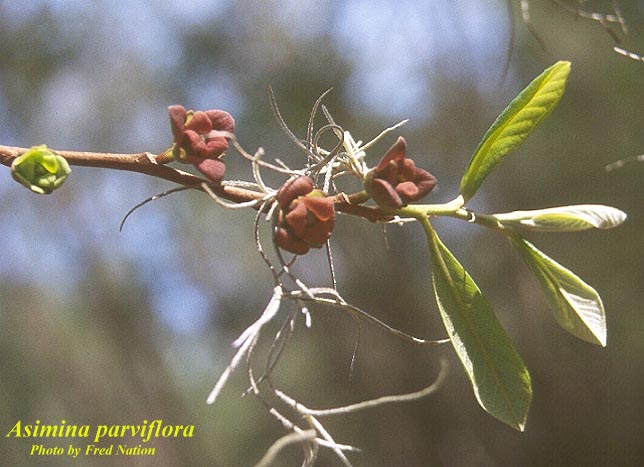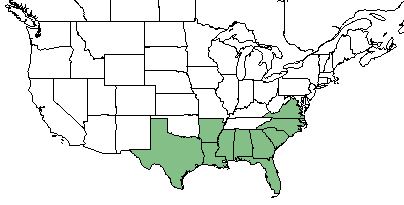Difference between revisions of "Asimina parviflora"
Emmazeitler (talk | contribs) (→Taxonomic Notes) |
|||
| Line 54: | Line 54: | ||
<!--==Diseases and parasites==--> | <!--==Diseases and parasites==--> | ||
| − | ==Conservation and | + | ==Conservation, cultivation, and restoration== |
| − | == | + | ==Cultural use== |
==Photo Gallery== | ==Photo Gallery== | ||
<gallery widths=180px> | <gallery widths=180px> | ||
</gallery> | </gallery> | ||
==References and notes== | ==References and notes== | ||
Revision as of 19:30, 7 June 2021
Common names: Small-flowered Pawpaw; Small-fruited Pawpaw
| Asimina parviflora | |
|---|---|

| |
| Photo by the Atlas of Florida Plants Database | |
| Scientific classification | |
| Kingdom: | Plantae |
| Division: | Magnoliophyta - Flowering plants |
| Class: | Magnoliopsida - Dicots |
| Order: | Magnoliales |
| Family: | Annonaceae |
| Genus: | Asimina |
| Species: | A. parviflora |
| Binomial name | |
| Asimina parviflora (Michx.) Dunal | |

| |
| Natural range of Asimina parviflora from USDA NRCS Plants Database. | |
Contents
Taxonomic Notes
Synonyms: none.[1]
Varieties: none.[1]
Description
A. parviflora is a perennial shrub tree of the Annonaceae family native to the southeastern United States. [2] Alternately arranged leaves that are simple, obovate or oblanceolate to oblong, entire, pointed at the tip, length up to 8 inches long, and some hairs on veins of lower surface. Bisexual flowers that are solitary, located in axils of the leaf scars, maroon, and have a slightly bad odor. Fruit are berries that are greenish yellow, and up to 3 inches long.[3]
Distribution
A. parviflora is found in the southeastern United States, particularly in Florida, Georgia, South Carolina, North Carolina, Alabama, Mississippi, Louisiana, Arkansas, and Texas. [2]
Ecology
Habitat
A. parviflora is a deciduous shrub found in the Coastal Plain in the southeastern United States. [4]
This species has been found on sparse loamy sands, moist sands, floodplains, woodland slope, and bottomland hardwood forests. [5] A. parviflora has been observed in dry-mesic hardwood hammock on a bluff above the Kissimmee River in Highland County Fl. This specimen is on the edge of it's southeastern range. .[6]
A. parviflora responds negatively to soil disturbance by clearcutting and chopping in North Florida flatwoods forests.[7]
Phenology
The A. parviflora flowers are the smallest in the Asimina genus with 4-6 maroon flowers per branch. The flowers are in bloom from February to May depending on the year. [4] It has been observed flowering in June as well.[8]
Seed dispersal
The A. parviflora is pollinated by insects including the greenbottle fly and nitidulid beetles.[4] This species is thought to be dispersed by consumption by vertebrates. [9]
Seed bank and germination
The fruit from A. parviflora requires an average of 3-4 months to mature and the number of seeds germinated is low compared to the initial population developed. [4]
Use by animals
A variety of flies are the most common visitor to the A. parviflora but they have not been traced to pollination, which is largely a result from beetles and the greenbottle fly.[4] It comprises 2-5% of diet for small mammals and terrestrial birds.[10]
Conservation, cultivation, and restoration
Cultural use
Photo Gallery
References and notes
- ↑ 1.0 1.1 Weakley, A.S. 2015. Flora of the southern and mid-atlantic states. Working Draft of 21 May 2015. University of North Carolina at Chapel Hill, Chapel Hill, North Carolina.
- ↑ 2.0 2.1 USDA Plant Database
- ↑ [[1]] Lady Bird Johnson Wildflower Center. Accessed: March 25, 2019
- ↑ 4.0 4.1 4.2 4.3 4.4 [Norman, E. M., et al. (1992). "Reproductive Biology of Asimina parviflora (Annonaceae)." Bulletin of the Torrey Botanical Club 119(1): 1-6.]
- ↑ URL: http://herbarium.bio.fsu.edu. Last accessed: June 2018. Collectors: Loran C. Anderson, Robert K. Godfrey, William Platt, M. Darst, H. Light, P. Isom, L. Peed. States and counties: Florida (Wakulla, Jefferson, Franklin, Leon, Lafayette), Georgia (Thomas)
- ↑ Observation by Edwin Bridgesr in Highlands County, Fl. on the kissimmee River, February 8, 2016, posted to Florida Flora and Ecosystematics Facebook Group February 8, 2016.
- ↑ Moore, W.H., B.F. Swindel, and W.S. Terry. (1982). Vegetative Response to Clearcutting and Chopping in a North Florida Flatwoods Forest. Journal of Range Management 35(2):214-218.
- ↑ Nelson, G. PanFlora: Plant data for the eastern United States with emphasis on the Southeastern Coastal Plains, Florida, and the Florida Panhandle. www.gilnelson.com/PanFlora/ Accessed: 25 MAR 2019
- ↑ Kirkman, L. Katherine. Unpublished database of seed dispersal mode of plants found in Coastal Plain longleaf pine-grasslands of the Jones Ecological Research Center, Georgia.
- ↑ Miller, J.H., and K.V. Miller. 1999. Forest plants of the southeast and their wildlife uses. Southern Weed Science Society.